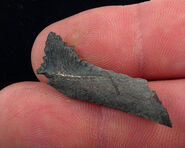| Edestus Fossil range: Late Carboniferous | |
|---|---|
 Edestus protopirata, from the Middle Carboniferous of the Moscow region. | |
| Scientific classification
| |
|
?Holocephali | |
|
Edestus | |
|
See text. | |
Edestus, also known as the Coal shark or the "Scissor-tooth shark", is a genus of shark that lived throughout the world's oceans during the Late Carboniferous Pennsylvanian age. All of the species are known only from their teeth. The term "edestid" is often used to refer to any or all members of the order Eugeneodontiformes, though, strictly speaking, "edestid" should be used only to refer to members of the family Edestidae.
Like its other relatives, such as Helicoprion, and unlike modern sharks, the species of Edestus grew teeth in curved brackets, and did not shed the teeth as they became worn. In Edestus' case, there was only a single row of teeth in each jaw, so that the mouth would have resembled a monstrous pair of pinking shears. The degree of curvature in the teeth brackets, along with size are distinct in each species.
Fossils[]
Teeth[]
The teeth of this genus exhibit a unique broad triangular crown with huge serrations. The roots are also quite unique as they appear as long arms with the crown at the end. The roots would interlock to form a "tooth-whorl."
Because the teeth are sharp and serrated, all of the species are presumed to have been carnivorous. Exactly how they captured, or even ate, their prey, along with their appearance, remains pure speculation until a more complete fossil, or skull, is found.
Species[]
- Edestus giganteus, (also known as the "scissor-tooth shark") lived in the oceans during the Late Carboniferous (306-299 million years ago).
Little is known about E. giganteus apart from a single set of teeth currently housed in the American Museum of Natural History in New York City. Paleontological studies suggest that E. giganteus, unlike modern-day sharks, did not shed worn or broken teeth. Rather, it continued growing new teeth and gums near the back of the mouth, eventually pushing the older teeth and gums forward, until they protruded from the mouth. It is not clear what function the strange teeth performed.
E. giganteus grew to about the size of the modern-day great white shark, thus probably making it one of the top sea predators of its day. As with all other members of the genus, it is not clear how E. giganteus caught or ate its prey, however.
- E. heinrichi
- E. mirus
- E. minor
- E. vorax
- E. newtoni
References[]
- Elasmo Research
- Mikko's Phylogeny Archive on Edestidae



